CENTER Publications
Below is a sample of recent publications by CSTPR faculty (Center personnel highlighted with multiple authors):
 Learning in the Aftermath of Extreme Floods: Community Damage and Stakeholder Perceptions of Future Risk Learning in the Aftermath of Extreme Floods: Community Damage and Stakeholder Perceptions of Future Risk
by E. A. Albright and D. A. Crow
Risk, Hazards & Crisis in Public Policy 6 (3) 308-328, doi: 10.1002/rhc3.12085, January 2016
Abstract: Policy learning in the aftermath of extreme events can happen as a result of changes in beliefs, attitudes, behaviors, and perceptions of stakeholders acting in a coordinated manner. Understanding the factors that impact these beliefs may prove critical in understanding policy learning and change, since these can mean the difference between ongoing flood vulnerability as a consequence of extreme weather events rather than long-term resilience. Data from in-depth interviews, stakeholder surveys, public meeting documents, and community demographics were used to analyze stakeholder processes and risk perceptions in seven Colorado communities that were flooded in 2013. Differences in extent of damages and resource capacity have led to a diversity of venues and participatory processes to manage flood recovery across the case communities. The results of the stakeholder survey suggest that perceptions of problem severity are linked to past flood experiences, type of expertise and job position. Taken together, these results suggest who participates in flood recovery processes, specifically their position and field of expertise, may influence how flood risks are perceived at the community level. Read more ... |
| |
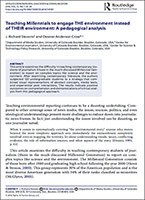 Teaching Millennials to Engage THE Environment Instead of THEIR Environment: A Pedagogical Analysis Teaching Millennials to Engage THE Environment Instead of THEIR Environment: A Pedagogical Analysis
by J. R. Stevens and D. A. Crow
Applied Environmental Education & Communication, Volume 15, Issue 1, 2016
Abstract: This article examines the difficulty in teaching contemporary students of journalism (those in the much-discussed Millennial Generation) to report on complex topics like science and the environment. After examining contemporary literature, the authors subjected 120 undergraduate students to a strategy that combined visual representations of abstract concepts, media texts, and experiential peer interactions. The results indicate positive outcomes on comprehension and demonstrations of critical analysis from this pedagogical approach. Read more... |
| |
 How Competing Securitized Discourses over Land Appropriation Are Constructed: The Promotion of Solar Energy in the Israeli Desert How Competing Securitized Discourses over Land Appropriation Are Constructed: The Promotion of Solar Energy in the Israeli Desert
by I. Fischhendler, D. Boymel, and M. T. Boykoff
Environmental Communication 10 (2) 147-168, doi: 10.1080/17524032.2014.979214, February 2016.
Abstract: Although solar farms are often favorably received by the public due to their contribution to clean energy, they are not conflict-free. In various contexts, this land-intensive technology often competes with other land uses like agriculture, nature reserves, and army training. As a result of this competition, interest groups often seek political leverage in order to prioritize their spatial use. Framing their uses as existential is one possible way to capture the attention of decision-makers. Yet, this securitization process may create a framing contest whereby different actors use similar securitization language to promote different land uses. This study is the first attempt to trace how this framing contest of securitized discourses over land appropriation is constructed. It is based on the Israeli experience of promoting solar energy in the Negev Desert, an area conceived as available to solar development. Through an analysis of protocols of Israeli policy-makers’ meetings between 2002 and 2011, the study documents the ways in which players adopt securitized language concerning various land uses such as energy, food, ecology, and traditional (national) security. The study found that the use of securitized framing varies between uses, forums, actors, and sectors. Yet competition between securities discourses remained uneven as, in the Israeli context, many players find it difficult to challenge the hegemonic role of traditional (national) security. Read more... |
| |
 Adaptation, Invited Contribution to Research Handbook on Climate Governance Adaptation, Invited Contribution to Research Handbook on Climate Governance
by L. Dilling
Chapter 41 in Research Handbook on Climate Governance, K. Bäckstrand and Eva Lövbrand, Eds., Edward Elgar Publishing, 2016
Abstract: As it becomes clearer that the earth is ‘committed’ to a certain amount of climate change despite greenhouse gas mitigation activities, the need for adaptation policy has been increasingly recognized. However, the fact that climate will be changing in uncertain and potentially unknown ways makes it difficult in many cases to develop firm prescriptive policy recommendations based on the environmental conditions of the future. As a result, the question of what successful adaptation policy looks like is still very much debated. Theoretical studies have advanced several different concepts of adaptation and its counterpart, vulnerability. The adaptation literature has focused on identifying characteristics of the decision process that might be effective in a deeply uncertain, highly contested and contextualized arena, such as flexibility, ‘robust’ decision-making, barriers that obstruct change, adaptive capacity, risk tolerance, and limits to adaptation. The discussion of limits has provoked considerations of transformational adaptation, and how and in what circumstances such transformations take place. Simple prescriptions for policy such as ‘no regrets’ or ‘low regrets’ actions seem inadequate as a substitute for true climate adaptation policy—although certainly may provide a useful starting place. Fundamentally we might ask: what is needed for effective governance for climate adaptation given the range of worldviews about risk? Does climate adaptation pose different governance challenges than responding to already recognized risk and uncertainty? And, even more importantly, what should various publics expect from decision-makers as they proceed to govern in the face of climate change? Read more...
|
| |
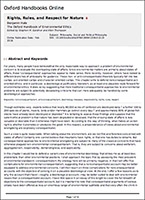 Rights, Rules, and Respect for Nature Rights, Rules, and Respect for Nature
by B. Hale
The Oxford Handbook of Environmental Ethics, Stephen M. Gardiner and Allen Thompson, Eds., 2016
Abstract: For years, many people have believed that the only reasonable way to approach a problem of environmental concern is to evaluate the eventuating state of affairs. Since environmental matters are primarily about states of affairs, these ‘consequentialist’ approaches appear to make sense. More recently, however, others have looked to different branches of philosophy for guidance. These non- or anti-consequentialist theorists typically fall into two camps: act-oriented camps and character-oriented camps. This chapter aims to defend nonconsequentialist act-oriented ethics, and in particular, a deontological justificatory liberalism, as at least one plausible route forward for environmental ethics. It does so by suggesting that more traditional consequentialist approaches to environmental problems are subject to potentially devastating criticisms that can more adequately be handled by some deontological approaches. Read more... |
| |
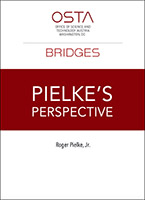 Pielke’s Perspective: A Collection of Articles from Bridges Pielke’s Perspective: A Collection of Articles from Bridges
by R. A. Pielke, Jr.
OST’s Publication on Science & Technology Policy, 93 pp., Center for Science and Technology Policy Research, July 2015
For 10 years, 2005-2014 Roger Pielke, Jr. wrote a quarterly column for Bridges, a newsletter on science policy by the staff of the Office of Science & Technology at the Austrian embassy in Washington, DC. All of Pielke’s columns have now been formatted into an e-Book. |
| |
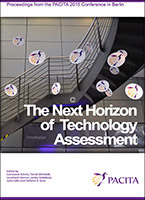 Technology Assessment as Political Myth? The Next Horizon of Technology Assessment Technology Assessment as Political Myth? The Next Horizon of Technology Assessment
by R. A. Pielke, Jr.
C. Scherz et al., Eds., Proceedings from the PACITA 2015 Conference in Berlin, January 2016.
Abstract: This short paper considers two topics of technology assessment in the context of political myth. The two subjects are the role of “basic research” in the innovation landscape and the so-called green revolution in agriculture. I argue that both examples exhibit properties of politic myth – the condensation of expectations of cause and effect into stories that we tell ourselves to justify commitments to one course of action or another. I argue that the making of wise decisions on innovation – in general or in a field such as agriculture – would benefit from opening up our political myths to scrutiny and, in some cases, challenging received wisdom. Read more... |
| |
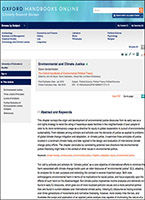 Environmental and Climate Justice Environmental and Climate Justice
by S. Vanderheiden
The Oxford Handbook of Environmental Political Theory, J. M. Meyer, T. Gabrielson, C. Hall, and D. Schlosberg, Eds., 2016
This chapter surveys the origin and development of environmental justice discourse from its early use as a civil rights strategy to resist the siting of hazardous waste facilities in the neighborhoods of poor people of color to its more contemporary usage as a directive for equity in global cooperation in pursuit of environmental sustainability. From debates among scholars and activists over the demands of justice as applied to problems of global climate change mitigation and adaptation, or climate justice, it examines three principles of justice invoked in a landmark climate treaty and later applied to the design and evaluation of international climate change policy efforts. The chapter concludes by considering potential new directions that environmental justice theorizing might take in the context of other issues in environmental politics. |
